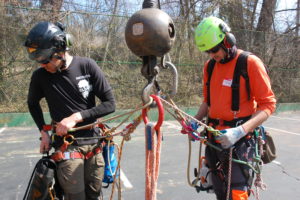Tree Risk Assessment is a fascinating genre in modern arboriculture. It is a mystical, magical place made up of matrixes. An underground world, behind the curtains of fantastic imagination. If you remember the movie with Keanu Reeves and Laurence Fishburne, you have a good conceptualization of what the fight scenes look like when it comes to assessing tree risk and preserving the right to life.
With the shovel of risk assessment, it seems as though the deeper you dig, the deeper the grave. To stand up for a risky tree unknowingly or without deep regard can be a liability, right? I mean, what if it went to litigation? Are you even insured for that? The lean of a tree? It’s like a lean on a home: impending and threatening and incapacitating. Looming and casting long, dark shadows, “it’s right outside my son’s bedroom” quoth the tree owner, “nevermore”. Oh, and the quantum mechanics of qualifying wood decay. Drilling and charting. Sending out samples to NASA and rolling out the caution tape like a crime scene in a hollywood studio. You need a shrink just to get through one municipal project.
Now come on with the whining already, with a little knowledge of tree biology comes the real power of jurisdiction. And with a deep knowledge comes an iron fist. Responsive growth, target classification and a thorough knowledge of mitigation options should, nay, shall! loosen us at the seems a little, eh? And, although maybe a bit ostensibly, when we look to trees internally and biologically and mechanically: with a probe, or a static pull test, we can see into the future. That squeaking you hear is not a shear plane crack singing in the breeze, it’s the tree risk assessor polishing their big crystal balls.
But this is no gimmick. It’s a story of luck and surface tension, I think. Have you ever heard if you shoot a bullet towards body of water at the right angle, it will ricochet off of the surface rather than piercing it? A dangerous experiment, no doubt, or maybe a myth, or maybe a good anecdote for tree risk assessment, because after all, angle is everything. Tree owners and tree managers many times use tree assessments and risk reports for economy and for planning, a scheduling of sorts, and of course to sort out internal and external conflicts, for legal matters or not. Understanding the correct angle of approach can, in some instances, swing the results favorably and land a hard sought victory. Maybe even for both teams. In order to see the angle perfectly, the scope of the project must be carefully dialed in. Are we viewing tree risk through a high performance optical tool, or is it a blurry and fleeting scene conjured up under the magical glass of a small orb?
In many cases, it’s not our personal trees we need to deem safe or unsafe, high risk or low risk, the likelihood of failure. Leave your emotions on the mat, friend. They are someone else’s woody beings, in a distant town or a local hamlet, and so we very quickly assume the roll of a sweaty financial consultant; we are asking clients how much risk they can afford; we are asking about budget and plans for the future. And then, of course, we need to disclose the consequences: negligible, minor, significant and severe. And, against the backdrop of all this black magic, hopefully the water don’t rise. Because in this risky business, nothing is guaranteed, friend. Except the photographic evidence of catastrophe, cataloged and curated like the Picasso collection.
The safest thing to do is cut it down, really. Take the payout. Why risk the exposure when you can just stuff the cash in the mattress? Dirty, sweaty cash. Like investing in local bonds. Or hiring the kindergarten magician. Boring. At least then you can sleep comfortably in the sharp night air, sharp like the edge of a rented chipper knife.
I’m not sure if Merlin really had crystal balls, but I really enjoy imagining him gallanting through the streets of local boroughs and big cities, wizardry garments big and flowing, I can see him floating along almost, taunting shade tree commissions hysterically, redirecting pedestrian traffic around haphazard and crumbling tree forms, casting spells at construction crews and unauthorized agents near the critical root zone, throwing a sorcery of Level 3 assessments everywhere like lighting, moving through the tree risk matrix of the world in blinding flashes and deafening booms.





Leave a Reply
Your email is safe with us.